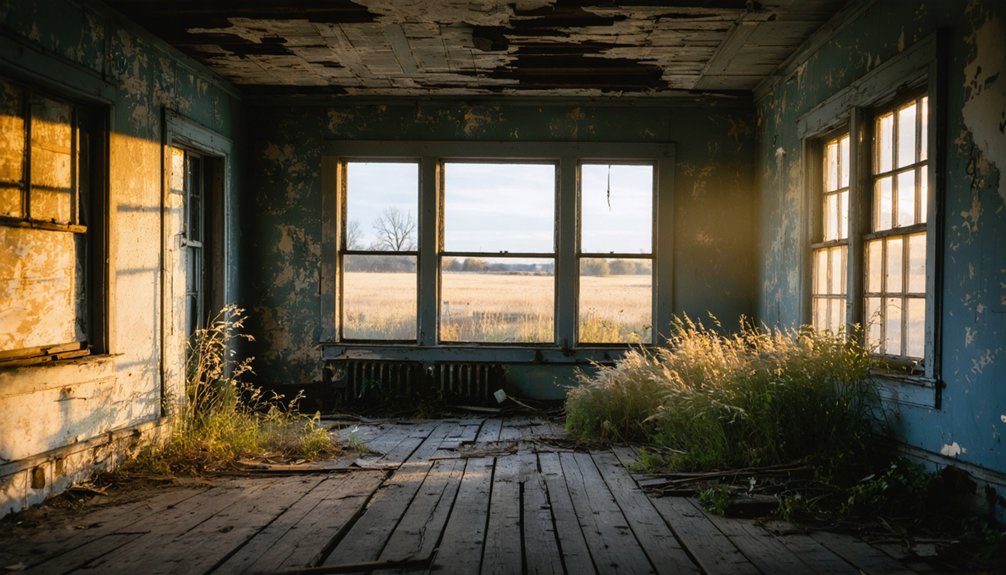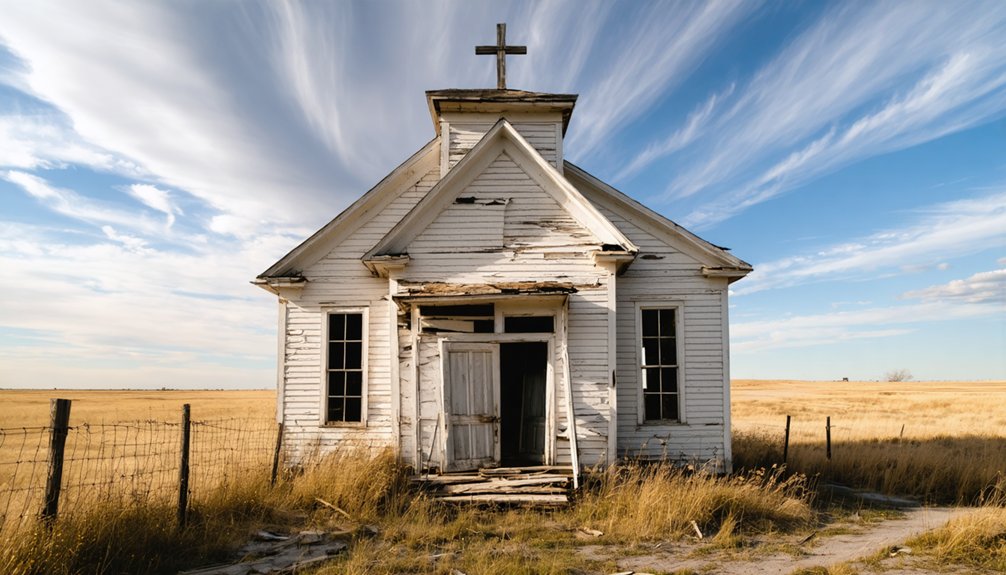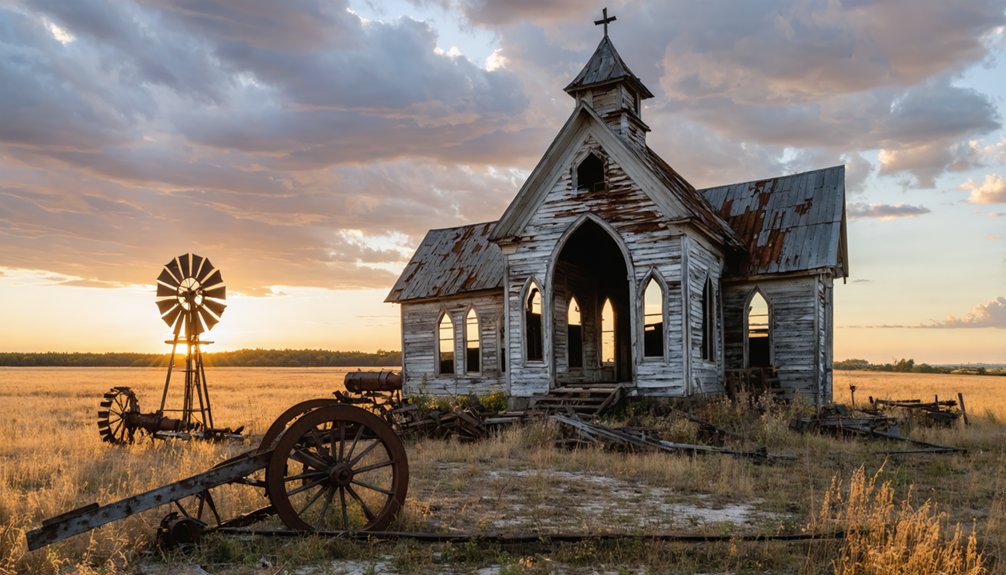You’ll find Gothland’s haunting ruins nestled in South Dakota’s Black Hills, where ambitious prospectors once sought their fortunes during the late 19th-century gold rush. The town flourished briefly with mining operations that produced over 83,000 pounds of lead, supported by essential railroad infrastructure and steam-powered machinery. After mining declined in the early 20th century, residents gradually abandoned the settlement. Today, scattered mining equipment and crumbling foundations tell a compelling story of boom-and-bust frontier life.
Key Takeaways
- Gothland emerged during the late 19th to early 20th century as a mining settlement during the Black Hills Gold Rush.
- The town’s mines produced 83,191 pounds of lead during peak operations before economic decline led to abandonment.
- Remnants include scattered mining equipment, railroad station foundations, and steam-powered machinery artifacts throughout the site.
- The ghost town requires careful navigation due to unstable structures, wildlife hazards, and remote location with unreliable cell service.
- Visitors can photograph historical structures during golden hour, with preservation status undocumented and no current restoration efforts.
Origins and Early Settlement
While the exact founding date of Gothland, South Dakota remains unclear, evidence suggests the settlement emerged during the late 19th to early 20th century amid the Black Hills Gold Rush. Driven by dreams of opportunity, early settlers established their presence through mining claims, homesteads, and basic infrastructure that shaped initial settlement patterns. Similar to the historical fascination that drives modern ghost town explorers, the site holds compelling stories of frontier life.
You’ll find Gothland’s origins reflect typical community dynamics of the era, starting as a modest gathering of pioneers who built rudimentary shelters and likely established essential services like a general store and post office. Like many of the ghost town remnants still visible today, Gothland showcases the rise and fall of early mining communities in the region.
The town’s name, possibly inspired by local geography or settler heritage, marked it as a distinct community among the scattered homesteads. Miners, farmers, and traders formed the backbone of this frontier outpost, creating a small but determined community in the challenging Black Hills terrain.
Mining and Railroad Legacy
Today you’ll find scattered mining equipment remnants from Gothland’s hard rock mining operations, which replaced earlier placer mining methods in the 1880s.
The town’s railroad infrastructure, essential for transporting ore and timber, is still visible through remaining station foundations that once connected Gothland to the larger Black Hills mining network. Early miners used free milling techniques to extract gold from the area’s deposits.
These industrial artifacts, alongside the ruins of chlorination processing facilities, tell the story of Gothland’s evolution from simple hand-milling operations to complex industrial mining processes. Similar to many towns in the region, Gothland emerged during the Black Hills gold rush that brought thousands of prospectors to the area.
Mining Equipment Remnants
The remnants of mining equipment scattered throughout Gothland offer a compelling window into South Dakota’s industrial past.
You’ll find evidence of the earliest mining machinery that once operated on steam power, with massive boilers that generated the energy needed to extract precious metals from the earth. These industrial artifacts tell a story of technological evolution, as steam-powered equipment gave way to more advanced mechanical systems.
Today, you can explore the better-preserved remnants in Gothland’s deeper mine shafts, where complex machinery and infrastructure have accumulated over time. Multiple passages branch throughout these shafts, revealing different stages of mining operations.
Historical production records show that mines in the area yielded 83,191 pounds of lead during peak operations.
While flooding and decay threaten many of these historical pieces, they remain valuable witnesses to the engineering innovations of their era.
These surviving artifacts help piece together the story of how miners extracted gold, silver, and other valuable minerals from the Black Hills.
Railroad Station Foundations
Among Gothland’s most striking historical features, concrete and stone foundations mark where the railroad station once connected this mining town to the wider world.
You’ll find these structural remains reflect the standardized station architecture used by major railroads like Milwaukee Road and Chicago & North Western throughout South Dakota’s early development. The layout followed a common T-shaped design with the commercial district perpendicular to the tracks.
The station’s foundations reveal the building’s original footprint, including areas designated for freight handling, telegraph operations, and separate waiting rooms for passengers.
These lasting elements demonstrate how the depot served as more than just a transit point – it was Gothland’s essential link for shipping mining equipment, ore, and supplies. Much like how local speculators invested in anticipation of railroad development elsewhere in South Dakota, the station’s strategic location shaped the town’s growth.
You can still spot remnants of the rail yard and nearby grain elevator foundations, evidence of the integrated rail infrastructure that once drove this town’s economy.
Daily Life in Peak Years
During Gothland’s peak years in the late 19th century, daily life centered around the demanding rhythms of mining and railroad work, with residents typically rising before dawn for long shifts underground or along the tracks.
Similar to Awanka’s residents, families patronized the two local hotels while settling into the area. Family dynamics revolved around adapting to these challenging work schedules, with wives and children often taking on multiple household responsibilities.
In your free time, you’d find social gatherings at the local saloons or general store, where you’d catch up on community news and share stories. Like many towns that suffered from decreased tourist traffic, Gothland eventually became a ghost town when the main highway was rerouted.
- Hunt and fish in the Black Hills during summer months for extra food
- Attend community events at the town hall with your neighbors
- Visit the post office to send letters to distant relatives
- Participate in seasonal celebrations that brought the tight-knit community together
Decline and Abandonment
As lucrative mining operations began drying up in the early 20th century, Gothland’s once-bustling economy entered a devastating downward spiral. Economic factors, including the collapse of agriculture and mining industries, forced residents to seek opportunities elsewhere.
The town’s failure to diversify its economy accelerated the decline.
Demographic shifts followed as younger generations abandoned Gothland for urban areas, leaving an aging population that couldn’t sustain local businesses. You can trace the town’s deterioration through census records and the post office’s closure in 1976.
Infrastructure crumbled as railway services ceased and harsh South Dakota weather took its toll on neglected buildings.
Despite attempts to preserve Gothland as a historical site or transform it into a tourist attraction, the lack of economic viability sealed its fate as another Black Hills ghost town.
Exploring the Ruins Today

When you’re exploring Gothland’s deteriorating structures today, you’ll need sturdy boots, a flashlight, and awareness of unstable surfaces to navigate safely around partially collapsed buildings and scattered debris.
You should maintain a respectful distance from weakened walls and rooflines while photographing the site’s historical features, taking care not to disturb any artifacts or structural elements.
Your visit requires careful route planning using GPS coordinates or local maps, as formal signage is minimal and many access roads are unpaved.
Safety Precautions When Visiting
Despite the allure of exploring Gothland’s historic ruins, visitors must prioritize safety given the site’s numerous hazards and remote location. Before venturing to this isolated ghost town, you’ll need proper safety gear including sturdy boots, layered clothing, and a well-stocked first aid kit.
Wildlife awareness is critical – watch for rattlesnakes in shaded areas and maintain distance from any animals you encounter.
- Never enter unstable structures or place hands where you can’t see
- Tell someone your plans and expected return time
- Bring emergency supplies and vehicle recovery equipment
- Stay on established paths and respect preservation laws
When exploring Gothland, remember that cell service is unreliable and weather conditions can change rapidly.
Always practice Leave No Trace principles and be prepared for self-rescue if needed.
Photography Best Practices
Photographing Gothland’s historic ruins requires careful preparation and technique to capture their haunting beauty while respecting the site’s preservation needs.
You’ll want to arrive during golden hour – either early morning or late evening – when the light casts long shadows and brings out the textures of weathered buildings. Equip yourself with a versatile camera, wide-angle and prime lenses, plus a sturdy tripod for low-light shots.
For the best composition tips, start with establishing shots of the town’s skyline, then move in closer to capture intimate details like rusted machinery and architectural features.
Don’t forget to document nature’s reclamation of the structures – vines climbing walls and trees growing through floorboards make compelling subjects.
Consider shooting in black and white to emphasize the timeless quality of your compositions.
As you explore Gothland’s remaining structures today, you’ll need to exercise extreme caution and follow strict safety protocols. Building identification can be challenging, with many structures reduced to foundations and partial walls.
When traversing the site, stick to these essential guidelines:
- Wear sturdy boots and protective clothing to guard against hazards like rusted nails and unstable surfaces.
- Stay on marked paths and avoid entering deteriorating buildings, which could collapse without warning.
- Use GPS or historical maps to identify key structures, as overgrown vegetation often obscures building remains.
- Look for distinctive architectural features like brick walls or wooden bars to determine original building purposes.
Keep a safe distance from unstable structures while documenting their locations.
Remember that careful navigation not only guarantees your safety but also helps preserve these fragile historical remnants for future visitors.
Preservation and Historical Significance

The preservation status of Gothland, South Dakota remains largely undocumented, with no specific restoration efforts currently recorded.
Like many ghost towns in South Dakota, preservation methods would typically involve local community initiatives and support from the State Historical Society, though no concrete plans are currently in place for Gothland.
You’ll find that ghost towns face significant preservation challenges, from weather damage to vandalism.
While specific details about Gothland’s historical significance aren’t well-documented, it represents part of South Dakota’s broader settlement narrative.
The site could serve as a valuable resource for historical education, offering insights into early settlement patterns and economic development in the region.
Through community engagement and potential collaboration with historical societies, there’s opportunity to protect whatever remains of this piece of South Dakota’s past.
Frequently Asked Questions
Are There Any Documented Paranormal Activities or Ghost Sightings in Gothland?
You won’t find officially documented Gothland hauntings or spectral sightings, though nearby Black Hills ghost towns have similar folklore about ghostly miners and settlers heard whispering through abandoned buildings.
What Happened to the Cemetery and Graves of Former Gothland Residents?
You’d be amazed how nature reclaims even our final resting places. While cemetery preservation records don’t exist for Gothland’s burial grounds, many similar ghost town graves either weathered away or underwent grave relocation to nearby towns.
Did Any Famous Outlaws or Historical Figures Ever Visit Gothland?
You won’t find any documented evidence of famous outlaws or historical figures visiting Gothland. While outlaws roamed South Dakota’s Black Hills region, there’s no proof they stopped in this small mining town.
Were There Any Major Fires or Natural Disasters in Gothland?
Like hitting “refresh” on history, you won’t find documented fire incidents or natural disasters in this town. The records show it faded away from economic decline, not dramatic catastrophes.
What Native American Tribes Originally Inhabited the Gothland Area?
You’ll find that Paleo-Indians first inhabited the region, followed by Mandan and Arikara tribes. By the 1700s, the Lakota heritage became dominant, with tribal legends centered around their spiritual connection to these lands.
References
- https://www.sdhspress.com/journal/south-dakota-history-2-2/some-black-hills-ghost-towns-and-their-origins/vol-02-no-2-some-black-hills-ghost-towns-and-their-origins.pdf
- https://www.youtube.com/watch?v=_0WNYsFLSLA
- https://www.blackhillsbadlands.com/blog/post/old-west-legends-mines-ghost-towns-route-reimagined/
- https://icatchshadows.com/okaton-and-cottonwood-a-photographic-visit-to-two-south-dakota-ghost-towns/
- https://www.youtube.com/watch?v=c8u4x31tzlo
- https://en.wikipedia.org/wiki/List_of_ghost_towns_in_South_Dakota
- https://www.legendsofamerica.com/south-dakota-ghost-towns/
- https://www.1880town.com
- https://www.onlyinyourstate.com/experiences/south-dakota/capa-ghost-town-sd
- https://www.sdpb.org/rural-life-and-history/2023-08-21/some-black-hills-ghost-towns-and-their-origins



